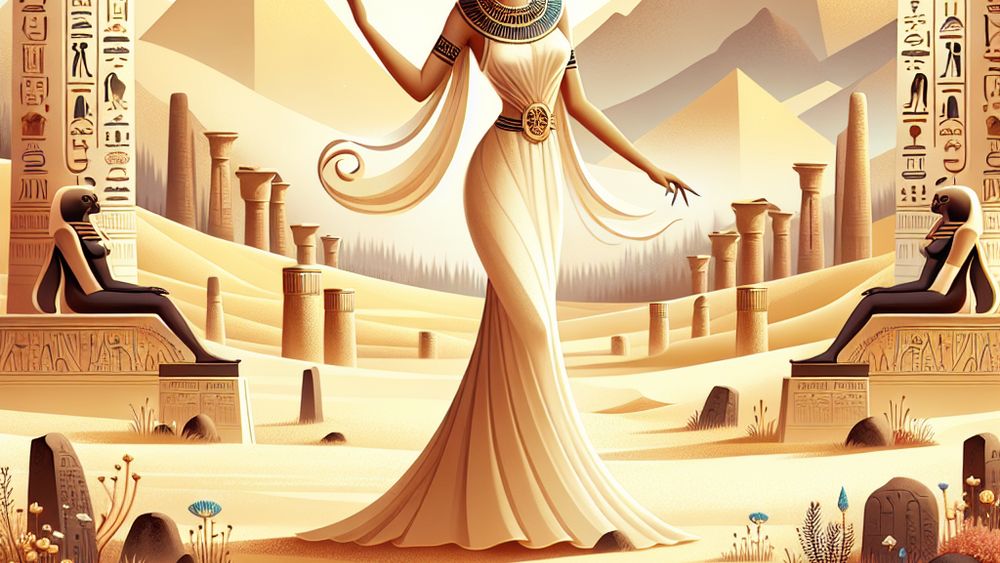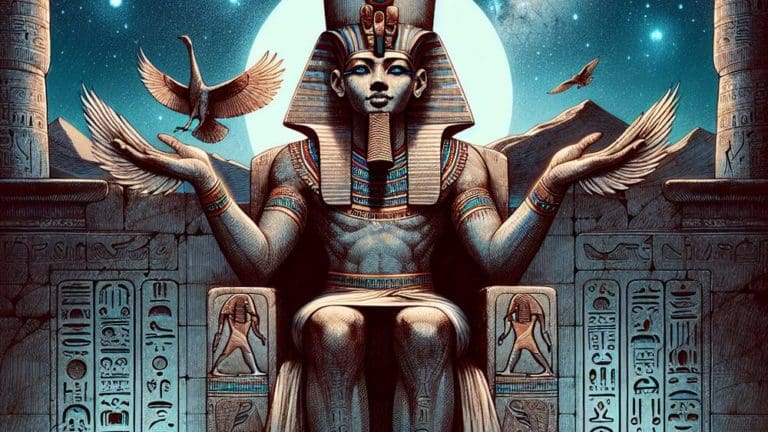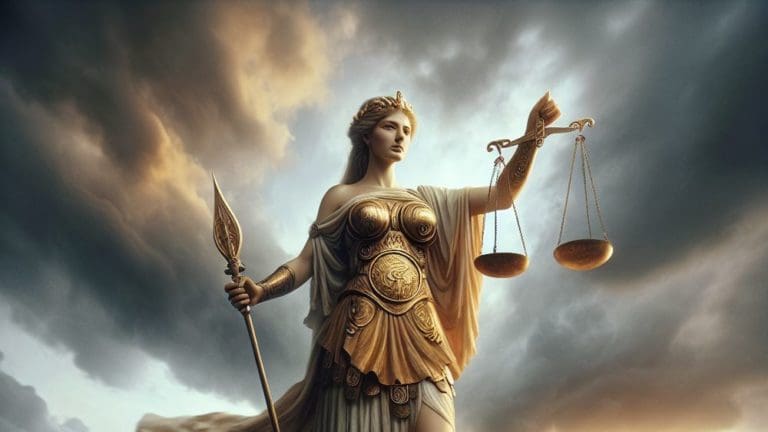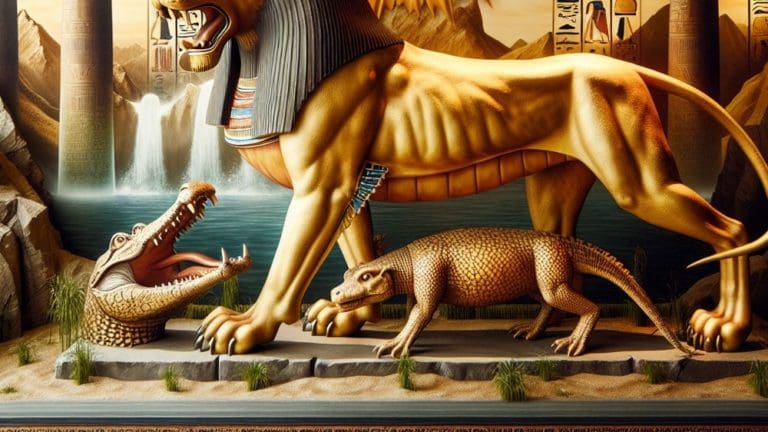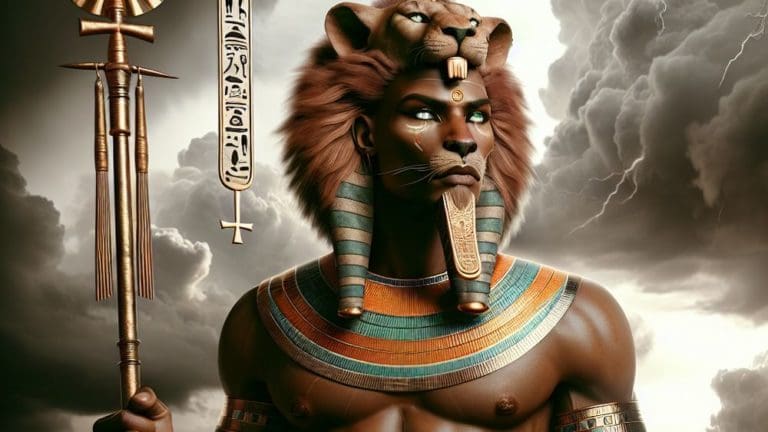Ultimate Guide To Egyptian God Serket: Mythology and Symbolism
Ultimate Guide To Egyptian God Serket: Mythology and Symbolism
Have you ever been captivated by the mysteries of ancient Egypt, its gods, and its myths? Among the pantheon of deities, the Egyptian god Serket stands out as a figure shrouded in mystery and intrigue. Her name alone, often associated with healing and protection, stirs the imagination and transports us to a time when gods walked among the sands of Egypt.
Key Points:
- Serket is an Egyptian goddess associated with healing, protection, and the afterlife.
- She was revered for her powers to cure venomous stings and bites and protect souls in the afterlife.
- Serket played a crucial role in the Osiris myth, ensuring the safety and resurrection of Osiris.
- Her symbolism includes being a scorpion goddess, healer, and symbol of motherhood.
- Serket’s worship evolved over time, with her image transitioning from a scorpion to a woman with a scorpion on her head.
- The tale of Serket and the Seven Scorpions highlights her protective and healing powers.
- Symbols associated with Serket include a woman with a scorpion head, holding an ankh, statues with scorpions, and depictions of priestesses and magicians.
Serket’s role as a guardian against venom and scorpions adds a layer of mystique to her persona. As we peel back the layers of history and myth, we reveal a deity whose significance is woven deeply into the fabric of ancient Egyptian society. Join me in uncovering the tales, symbols, and powers attributed to this enigmatic goddess.
Exploring the Origins and Roles of Serket in Egyptian Mythology
In the grand tapestry of ancient Egyptian myths, Serket emerges as a complex and enigmatic figure. Her origins, shrouded in the mists of time, suggest a deity deeply intertwined with the concepts of healing, protection, and the afterlife. As we explore the roles and reverence attributed to Serket, we embark on a journey to understand her pivotal place in ancient Egyptian religious practices and the everyday lives of its people.
The Historical Significance of Serket
The goddess Serket has held a place of profound reverence in ancient Egyptian religion for millennia. Her significance stems from several key aspects:

- Healing: Renowned for her powers to cure venomous stings and bites, Serket was often invoked for medical protection.
- Protection of Souls: She played a crucial role in the afterlife, ensuring the safety of souls as they journeyed to the underworld.
- Guardian of the Pharaoh: Serket was believed to act as a bodyguard to the pharaoh, offering a divine shield against treachery and harm.
These attributes underscore her multifaceted nature as both a nurturer and a protector, extending her influence from the realms of health to the eternal afterlife.
Serket’s multifaceted nature as a nurturer and protector highlights her significance in ancient Egyptian religion.
Serket’s Role in the Osiris Myth
Within the tapestry of ancient Egyptian mythology, Serket’s role in the Osiris myth highlights her importance as a deity of protection and magic. Key aspects of her involvement include:
- Protector of Osiris: As Osiris ventured into the afterlife, Serket was among the deities who ensured his safety and resurrection.
- Ally of Isis: As the sister of Isis, Serket lent her magical skills to assist in the battle against Set, the god of chaos.
- Guardian: Her healing powers were crucial in the restoration of Horus, ensuring the continuation of the divine lineage.
These roles underscore Serket’s vital presence at the heart of one of the most pivotal myths in ancient Egyptian lore, showcasing her godly powers and her unwavering dedication to protection and familial loyalty.
The Protective Powers and Symbolism of Serket
Serket’s protective powers and symbolism held significant meaning in ancient Egyptian culture, reflecting her vital role in the pantheon of gods. Key aspects of her protective aura include:
- Scorpion Goddess: As the deity associated with scorpions, Serket symbolized protection from venom and harm, embodying the dual nature of danger and safeguarding.
- Healer: Her mastery over healing reinforced her status as a guardian against disease and injury, portraying her as a beacon of hope and renewal.
- Symbol of Motherhood: Frequently depicted as a fierce protector of children and families, Serket embraced the role of mother goddess, underlining the unbreakable bond between protection and nurturance.
These symbols and powers of Serket cast her as a deity whose essence was integral to the fabric of ancient Egyptian life, encompassing not only the physical but also the spiritual well-being of the civilization.
Serket’s symbolism as a Scorpion Goddess, Healer, and Symbol of Motherhood emphasized her crucial role in ancient Egyptian society’s well-being and protection.
The Worship and Representation of Serket Through the Ages
Throughout the sands of time, the worship and representation of Serket have undergone a remarkable transformation, evolving with the changing dynasties of ancient Egypt. From simple stone carvings to grand temple inscriptions, Serket’s presence has been a constant protectorate force, guarding the souls of the deceased and offering healing to the living.
This transition not only highlights her significance in the pantheon of ancient Egyptian deities but also encapsulates the enduring fascination with Serket as a goddess of magic, healing, and protection. Her evolution is a testament to the resilience and adaptability of ancient Egyptian religious practices, as well as the deep-seated reverence for Serket that has withstood the test of time and change.
Evolution of Serket’s Image and Worship
The image and worship of Serket have significantly evolved from ancient times to the post-dynastic periods, reflecting changes in societal beliefs and artistic styles. Initially depicted as a scorpion, her iconography expanded to include a woman with a scorpion on her head, symbolizing protection and healing powers.

- Early Dynastic Period: Serket was primarily a protector against venomous creatures. Her image was minimalistic, emphasizing her connection with scorpions.
- Middle Kingdom: The role of Serket expanded to include the protection of the pharaoh, and her worship became more widespread among the common people.
- New Kingdom: Serket’s iconography evolved significantly, often depicted as a woman with a scorpion on her head or holding ankh, the symbol of life, reflecting her roles in healing and protecting the souls of the deceased.
- Ptolemaic Period: Her worship saw renewed interest, with statues and temples being erected in her honor, and her role as a protector and healer was emphasized in religious texts. [1]
The evolution of Serket’s image and worship underscores her lasting significance in ancient Egyptian culture, adapting to meet the spiritual needs of the society over millennia.
Serket and the Seven Scorpions: A Tale of Protection
The tale of Serket and the Seven Scorpions is a captivating story that symbolizes the goddess’s protective powers. It narrates how Serket, with her seven scorpion companions, journeyed through the desert to protect Isis and the infant Horus from Set, the god of chaos.
- First Layer of Protection: The scorpions forged a protective circle around Isis and Horus, guarding them against any physical and magical attacks from Set.
- Second Layer of Protection: Serket herself wielded her healing powers to shield Isis and Horus from venomous creatures and disease, symbolizing her role as a guardian and healer.
This story beautifully illustrates how Serket’s protective and healing abilities were not only crucial for the gods but also revered and sought after by the ancient Egyptians for their safety and well-being in both life and afterlife.
Artistic Depictions and Sacred Symbols of Serket
The way Serket has been depicted in art and the symbols associated with her offer deep insights into her role and importance in ancient Egyptian culture.
| Symbol/Depiction | Significance |
|---|---|
| Woman with scorpion head | Symbolizes Serket’s protection against scorpions and other venomous creatures. |
| Holding ankh | Represents her role in healing and granting eternal life to souls in the afterlife. |
| Statue with scorpions | Statues often featured Serket with one or more scorpions, emphasizing her protective qualities. |
| Priestesses and magicians | Depicted performing rites in her honor, highlighting her association with magic and healing. |
These artistic representations and symbols echo Serket’s enduring legacy as a goddess of protection, healing, and guardianship over the souls of the ancient Egyptian world.
Serket’s artistic depictions and symbols reveal her as a powerful goddess of protection, healing, and guardianship in ancient Egyptian culture.
FAQs
1. How was Serket worshipped in ancient Egypt?
In ancient Egypt, Serket was worshipped primarily as a protector against venomous stings and bites. Her temples were places where healing rituals took place, emphasizing her role as a guardian against poisons and her association with medicine and healing.
2. What symbols are associated with Serket?
Symbols associated with Serket include the scorpion, which signifies protection and healing. Another symbol is the ankh, representing life and healing, linking Serket closely with the well-being of ancient Egyptian people.
3. Can you explain the connection between Serket and the scorpion?
The connection between Serket and the scorpion is rooted in her role as a protector. The scorpion, both feared and respected, symbolizes Serket’s power over venom and her ability to heal and guard against poisonous threats.
4. How does Serket’s role in the Osiris myth highlight her importance?
Serket’s role in the Osiris myth underscores her importance through her protection of Isis and Horus. She represents the healing and safeguarding of the family unit, showcasing her vital role in ancient Egyptian religion and mythology.
Conclusion
Diving into the world of the Egyptian god Serket offers a fascinating glimpse into the past, where deities played a central role in the daily life and afterlife expectations of the ancient Egyptians. From her protective powers to her significance in the Osiris myth, Serket embodies the spirit of healing and guardianship that transcends time. Her symbolism, deeply entwined with scorpions and healing, prompts us to explore the layers of meaning behind the goddesses and gods that shaped ancient beliefs. As we close this chapter on the egyptian god Serket, let it be an invitation to you, dear readers, to keep peeling back the mystical layers of history, discovering connections to our present, and perhaps finding a bit of magic in the process. Warm regards and until our next adventure into the annals of time, Cedric.

